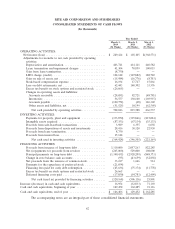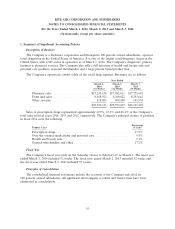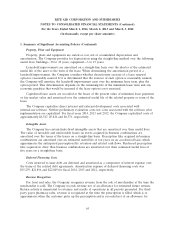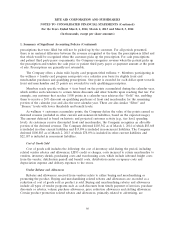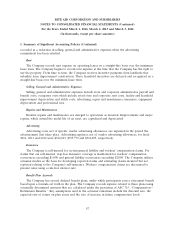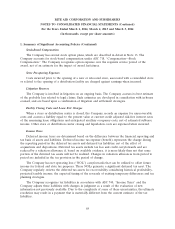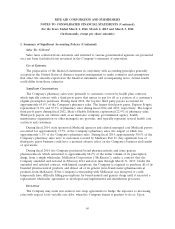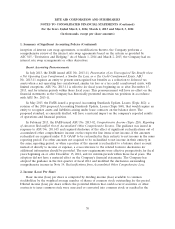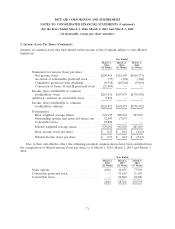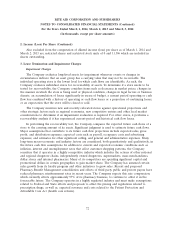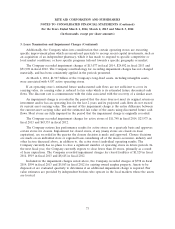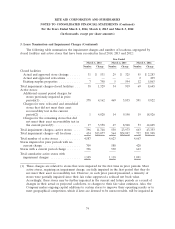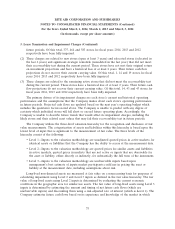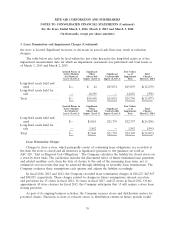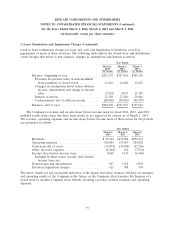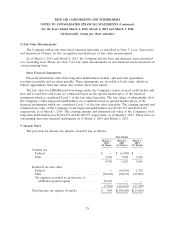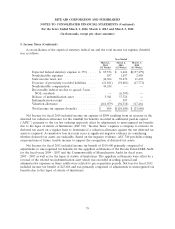Rite Aid 2014 Annual Report Download - page 73
Download and view the complete annual report
Please find page 73 of the 2014 Rite Aid annual report below. You can navigate through the pages in the report by either clicking on the pages listed below, or by using the keyword search tool below to find specific information within the annual report.RITE AID CORPORATION AND SUBSIDIARIES
NOTES TO CONSOLIDATED FINANCIAL STATEMENTS (Continued)
For the Years Ended March 1, 2014, March 2, 2013 and March 3, 2012
(In thousands, except per share amounts)
2. Income (Loss) Per Share (Continued)
Also excluded from the computation of diluted income (loss) per share as of March 1, 2014 and
March 2, 2013 are restricted shares and restricted stock units of 0 and 11,506 which are included in
shares outstanding.
3. Lease Termination and Impairment Charges
Impairment Charges
The Company evaluates long-lived assets for impairment whenever events or changes in
circumstances indicate that an asset group has a carrying value that may not be recoverable. The
individual operating store is the lowest level for which cash flows are identifiable. As such, the
Company evaluates individual stores for recoverability of assets. To determine if a store needs to be
tested for recoverability, the Company considers items such as decreases in market prices, changes in
the manner in which the store is being used or physical condition, changes in legal factors or business
climate, an accumulation of losses significantly in excess of budget, a current period operating or cash
flow loss combined with a history of operating or cash flow losses or a projection of continuing losses,
or an expectation that the store will be closed or sold.
The Company monitors new and recently relocated stores against operational projections and
other strategic factors such as regional economics, new competitive entries and other local market
considerations to determine if an impairment evaluation is required. For other stores, it performs a
recoverability analysis if it has experienced current-period and historical cash flow losses.
In performing the recoverability test, the Company compares the expected future cash flows of a
store to the carrying amount of its assets. Significant judgment is used to estimate future cash flows.
Major assumptions that contribute to its future cash flow projections include expected sales, gross
profit, and distribution expenses; expected costs such as payroll, occupancy costs and advertising
expenses; and estimates for other significant selling, and general and administrative expenses. Many
long-term macro-economic and industry factors are considered, both quantitatively and qualitatively, in
the future cash flow assumptions. In addition to current and expected economic conditions such as
inflation, interest and unemployment rates that affect customer shopping patterns, the Company
considers that it operates in a highly competitive industry which includes the actions of other national
and regional drugstore chains, independently owned drugstores, supermarkets, mass merchandisers,
dollar stores and internet pharmacies. Many of its competitors are spending significant capital and
promotional dollars in certain geographies to gain market share. The Company has assumed certain
sales growth from its loyalty program and other initiatives to grow sales. Recent and proposed
Pharmacy Benefit Management consolidation and efforts of third party public and private payers have
reduced pharmacy reimbursement rates in recent years. The Company expects this rate compression,
which currently affects approximately 97% of its pharmacy business, to continue to affect it in the
foreseeable future. The Company operates in a highly regulated industry and must make assumptions
related to Federal and State efforts and proposals to affect the pricing and regulations related to
prescription drugs, as well as, expected revenues and costs related to the Patient Protection and
Affordable Care Act (health care reform).
72


